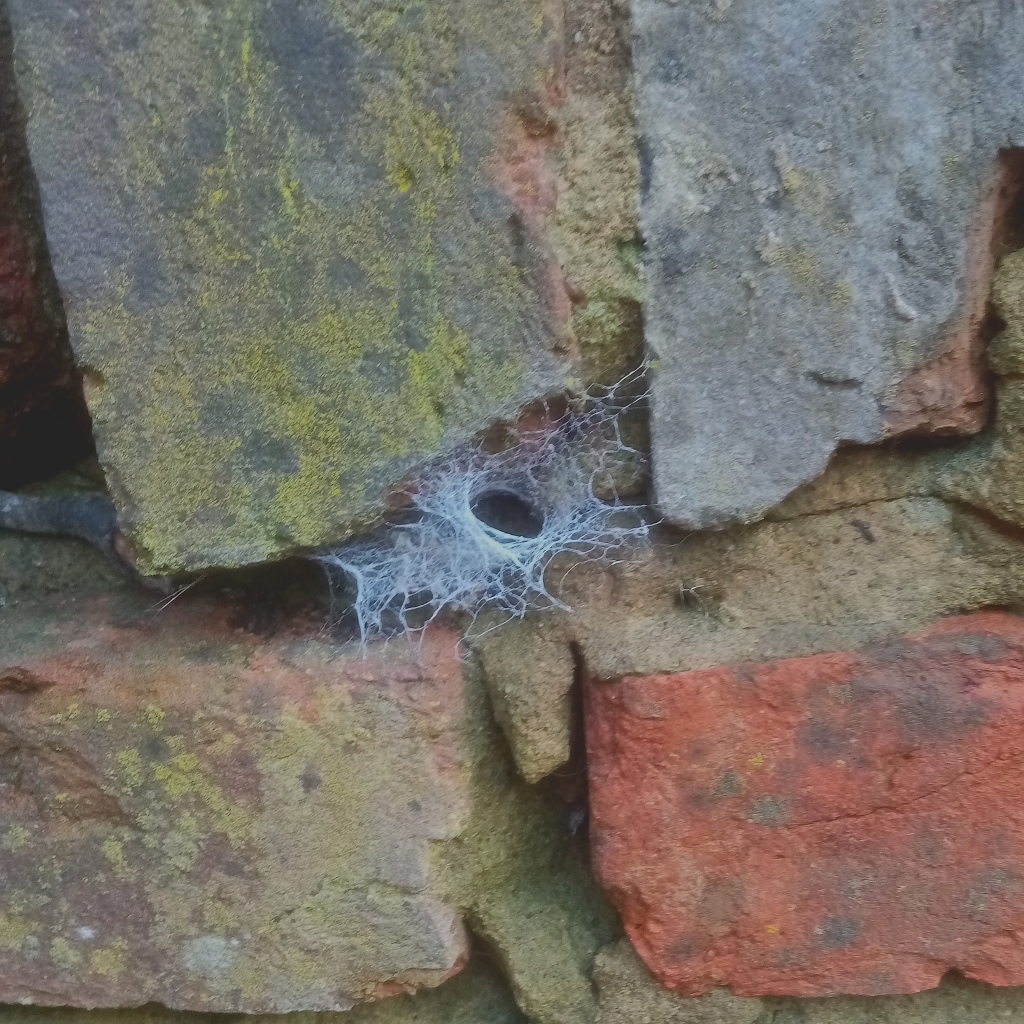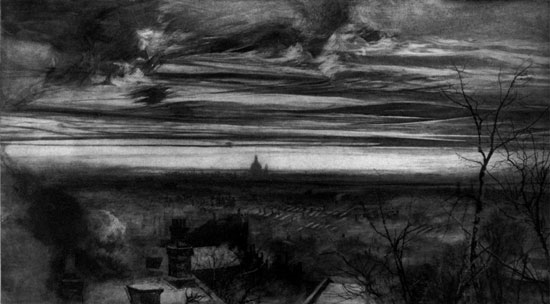
The wall is not going to win prizes for its brickwork, but the cracks and crevices provide shelter for many creatures including a trapdoor spider. It’s probably hibernating a few centimetres back from the doorway.


When we looked at the bug hotel the other day, we saw this scattering of wood dust, a sure sign that some creature has dug its way in, or more likely its way out of, one of the logs. We’ve also seen spiders’ webs, so it looks like some residents are ready to eat other residents.
I don’t fancy going on holiday to stay in an hotel like that!
Here is a post about the old and new bug hotels.

Not a view of London any of us will have seen, though the crowded streets are still there. Saint Paul’s too, but it has been overshadowed by the temples of Mammon. This picture and text are from ‘London Impressions’ by Alice Meynell, illustrated by William Hyde, pub; Archibald Constable, 1898, available on Project Gutenberg.
Now and then a firefly strays from the vineyard into the streets of an Italian city, and goes quenched in the light of the shops. The stray and waif from ‘the very country’ that comes to London is a silver-white seed with silken spokes or sails. There is no depth of the deep town that this visitant does not penetrate in August—going in, going far, going through, by virtue of its indescribable gentleness.
The firefly has only a wall to cross, but the shining seed comes a long way, a careless alien but a mighty traveller. Indestructibly fragile, the most delicate of all the visible signs of the breeze, it goes to town, makes light of the capital, sets at nought the thoroughfares and the omnibuses, especially flouts the Park, one may suppose, where it does not grow. It hovers and leaps at about the height of first-floor windows, by many a mile of dull drawing-rooms, a country creature quite unconverted to London and undismayed. This flâneur makes as little of our London as his ancestor made of Chaucer’s.
Sometimes it takes a flight on a stronger wind, and its whiteness shows dark with slight shadow against bright clouds, as the whiter snow-flake also looks dark from its shadow side. Then it comes down in a tumult of flight upon the city. It is a very strong little seed-pod, set with arms, legs, or sails—so ingeniously set that though all grow from the top of the pod their points together make a globe; on these it turns a ‘cart-wheel’ like a human boy—like many boys, in fact, it must overtake on its way through the less respectable of the suburbs—only better. Every limb, itself so fine, is feathered with little plumes that are as thin as autumn spider-webs. Nothing steps so delicately as that seed, or upon such extreme tiptoe. But it does not walk far; the air bears the charges of the wild journey.
Thistle-seeds—if thistle-seeds they be—make few and brief halts, then roll their wheel on the stones for a while, and then the wheel is a-wing again. You encounter them in the country, setting out for town on a south wind, and in London there is not a street they do not recklessly stray along. For they use our arbitrary streets; it does not seem that they make a bee-line over the top of the houses, and cross London thus. They use the streets which they treat so lightly. They conform, for the time, to human courses, and stroll down Bond Street and turn up Piccadilly, and go to the Bank on a long west wind—their strolling being done at a certain height, in moderate mid-air.”
They generally travel wildly alone, but now and then you shall see two of them, as you see butterflies go in couples, flitting at leisure at Charing Cross. The extreme ends of their tender plumes have touched and have lightly caught each other. But singly they go by all day, with long rises and long descents as the breeze may sigh, or more quickly on a high level way of theirs. Nothing wilder comes to town—not even the scent of hay on morning winds at market-time in June; for the hay is for cab-horses, and it is at home in the clattering mews, and has a London habit of its own.
White meteor, lost star, bright as a cloud, the seed has many images of its radiant flight. But there is only one thing really like it—the point of light caught by a diamond, with the regular surrounding rays.
The other night I noticed that the hole where the leaf cutter bee once laid her eggs was occupied again, I think by another setting of bee’s eggs. The hole next door – well, those four black legs have four more behind them, Any nocturnal insect or woodlouse walking by would not know what hit them.
I was once tempted to plug those holes, for tidiness’ sake. I’m glad I didn’t.

Let’s make this a small picture for you arachnophobes! This is a plea to be kind to the spiders that cannot get out of the bath. It’s that time of year. Don’t try to scoop them up in your hand or a cup, just drape a towel so that one end rests inside on the bottom of the bath. Then she can climb out when she’s ready.
Of course, a true arachnophobe can then worry in case the hairy little creature is in the folds of the towel when you come to dry yourself…
In the middle of the night, I met this spider in the kitchen. Whose home is this? I wondered. I brought my finger gently up beneath that outstretched foot; as soon as finger and foot met, the spider spun and bounced frenetically at the end of it’s thread, but then resumed station between fridge and breadbin.
How many flies has it eaten over its short life? Why does it have no more than six legs? Or am I missing something?